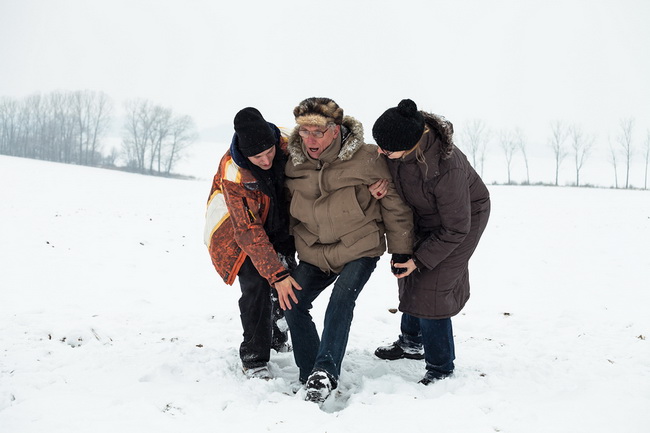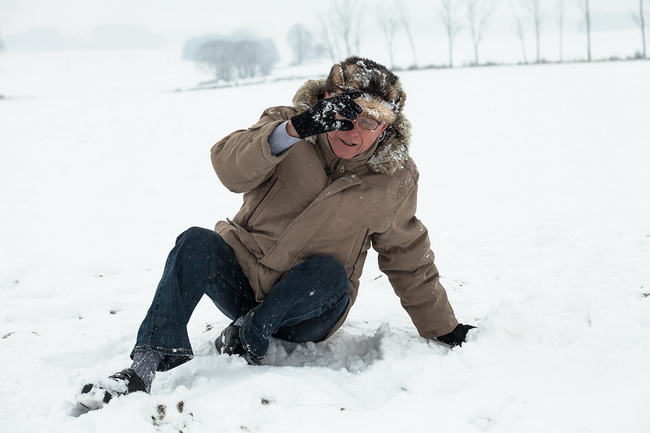- Make It Yourself Lavender Heart-Shaped Bath Bombs!
- 20 Things You Never Knew About “Down There”
- 12 Best Foods For Those Suffering From Arthritis Pain
- 12 Personal Hygiene Mistakes Almost Everyone Makes (Mom Never Told You About #4!)
- 15 Medicinal Plants And Herbs From The Cherokee People
- 12 Mind-Blowing Benefits Of Drinking Coconut Water During Pregnancy
- 12 Outstanding Winter Foods That Won’t Fatten You Up Like A Christmas Turkey
Smart Ways To Avoid A Nasty Fall This Winter

Photo credit: bigstock.com
This time of year, with a ton of snow, freezing rain, and ice everywhere, unless you have plans to just hibernate until spring, you are going to have to go outside and face the elements. It’s a pretty safe bet too that, one day, you are going to slip and slide like a kid on a waterslide.
Although everyone laughs out loud at those funny videos of people falling down on the ice, it’s really no laughing matter. In 2011, more than 22,000 adults died from injuries that involved falling, most of them occurring in the winter months, according to the Centers for Disease Control and Prevention.
In fact, diet doctor Dr. Robert Atkins met his death from a head injury he received after falling on an icy sidewalk right outside his office door.
Most falls can be avoided, however. Keep reading for our top tips for walking outside safely during these icy winter months.
1. The Obvious: Watch Where You Step
OK, this might seem like the no brainer of the century, but think of all the people you see texting, checking their phone, or window shopping when walking. When walking outside, always be aware of the surfaces you are on. It’s much better to be on the safe side and assume that there is ice under that light, fluffy layer of new snow. Just because you can’t see ice does not mean that it is not there. If you find you must walk uphill or downhill, always try to find a grassy edge to walk on so you have better traction. You might also want to keep an eye out for something to grab onto in case you fall. Leave your phone in your pocket or purse and look at it after you are safely indoors or are sitting down.
2. Get Physically Active
The more fit and stronger you are the less likely you are to take a tumble. Exercising will help prevent you from falling because it improves your sense of balance and makes your muscles not only stronger, but more flexible.
3. Wear Socks OVER Shoes
Don’t laugh, this works! Putting a pair of socks over your shoes is not only an extra layer of insulation, but it’s an effective form of traction! (They are cheap, too!) This is an especially good idea for toddlers, small children, and the elderly. Don’t be shy! Start a new fashion trend! Wear some socks over your shoes and if someone laughs, you can laugh at them when they fall on their behinds!
YOU MIGHT ALSO LIKE: Top Secrets to Beat the Winter Blues, Feel More Energized, & Skip the Flu
4. Forget Pockets, Wear Gloves
How can gloves keep you from falling? Think for a moment: when you feel yourself start to slip and fall, what is the first thing you do? Put your arms out for balance, right? So rather than keeping your hands in your pockets and decreasing your center of gravity, wear gloves so you can use your arms for balance.
5. Give Your Grandparents Ski Poles
For elderly persons, especially those who need to use a cane, a pair of Nordic poles can be a lifesaver. Using a pair of Nordic ski poles, elderly persons can balance on all fours, so to speak, and feel much more confident when they are walking in icy conditions. Studies show that these are a much more effective solution to a cane in bad weather situations.
Continue to Page 2

Photo credit: bigstock.com
6. Think More Like a Penguin
In icy weather, walking normally just isn’t smart. Heck, sometimes, it’s not even possible! So this time of year, it’s time to take a cue from our penguin friends. Think about how they shuffle along. Take short, flat footed, baby type steps and point your feet outwards slightly. Don’t step up on your toes; try to even out your weight between your two feet. Bend your knees just a bit and do the penguin shuffle. Watch a video of how they shuffle along on the ice to get an idea of just how it should be done.
7. Use Kitty Litter
If you walk regularly, say from the parking lot to your office, on icy surfaces, bring along a small zip lock baggie with (clean) kitty litter. Throwing some of it in front of you will help give you a little traction so you don’t fall on your butt in front of your boss.
8. Smart Shoe Choices
Although everyone loves the comfort of sneakers, they simply aren’t snow friendly. Forget about those sneakers or other shoes with smooth bottoms for ones that have better traction. Try boots with non-slip neoprene or rubber soles. You can also buy some crampons, which is what professional ice climbers use. These simply slip over your existing shoes and the metal plates dig into the ice for better traction.
9. Stay Off the Streets
Although the street is generally plowed first so many are tempted to walk there, you should remember that cars and trucks slide as easily as people do. Walking in the street might mean you put yourself in the path of an SUV being driven by someone in a rush for that 3 hour Christmas sale at the mall.
SEE ALSO: Top Tips and Herbs That Will Keep You Warm this Winter
10. When All Else Fails
OK, despite your best efforts, when you know you can’t avoid it and you are going to fall, at least fall in such as a way that you minimize damage to your body.
Lean towards the direction of the fall and just roll into it. Try to fall on your side rather than on your knees, wrist, or tush. Although the tush might seem ideal, especially if yours is well padded, you can fall directly on your tailbone and cause damage up your entire spine this way, much like hitting a nail head with a hammer. Falling on your side, if possible, will help distribute your weight more evenly and greatly reduce your chances of breaking anything.
Prevention takes very little time and it will go a long way towards making sure you stay safe or, if you do fall, you will have nothing more to show for your little icescape than a few bruises.

































